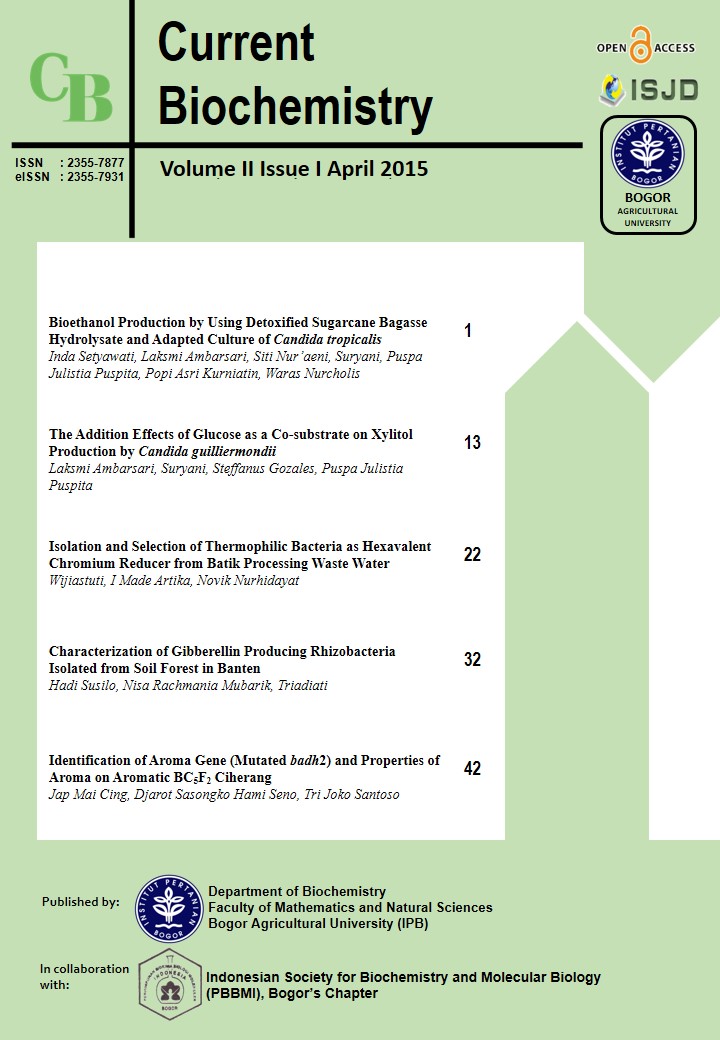Identification of Aroma Gene (Mutated <i>badh</i>2) and Properties of Aroma on Aromatic BC<sub>5</sub>F<sub>2</sub> Ciherang
Abstract
Aromatic rice varieties have some weaknesses such as low productivity, and less resistant to pests and diseases. This study aimed to obtain homozygous strain of BC5F2 Ciherang aromatic through the identification of aroma gene (mutated badh2) and properties of the aroma. Ciherang paddy (nonaromatic paddy) was used as the female parent, whereas Mentik Wangi paddy (aromatic paddy) was used as the male parent. The experiment was conducted in BC5F2 because it is expected to generate plants with properties 98.4% close to female parent. The DNA from five strains of paddy plants BC5F2Ciherang X Mentik Wangi was isolated by a modified CTAB method. The concentration of DNA was determined by measuring absorbance at 260 nm wavelength, while its purity was determined from the ratio of the absorbance at a wavelength of 260/280 nm. PCR-based molecular selection was done by using the Bradbury primers. PCR results showed that of the 250 samples, there were 66 samples had DNA fragment of the same size as that of Mentik Wangi, i.e. 257 bp, 67 samples had the same size as the DNA fragment of Ciherang, i.e. 355 bp, and 117 samples had the same size with the both of DNA fragments, i.e. 257 bp and 355 bp. Plants with amplified 257 bp DNA fragment was subjected to leaf aroma test using 1.7% KOH. The results showed that 42 positive samples, out of 66 samples. Samples positive on leaf aroma test were tested again on rice aroma test. Rice aroma test results showed the majority (85.4%) samples that are positive on leaf aroma test is also positive on the rice aroma test.
References
Bradbury LM, Fitzgerald TL, Henry RJ, Jin Q, Waters DLE. 2005a. The gene for fragrance in rice. Plant Biotech. J. 3:363–370.
Bradbury LMT, Henry RJ, Jin Q, Reinke RF, Waters DLE. 2005b. A perfect marker for fragrance genotyping in rice. Mol. Breed 16:279–283.
Dong, Y, E Tsuzuki, and H.Terao. 2001. Genetic analysis of aroma in three rice cultivars (Oryza sativa L.). J Genet Breed 55: 39-44.
Doyle JJ, Doyle JL. 1987. A rapid DNA isolation from small amount of fresh leaf tissue. Phytochem Bull 19: 11-15.
Fatahajudin MT. 2011. Introduksi gen aroma (badh2 termutasi) dari varietas Pandan Wangi atau Mentik Wangi ke Ciherang [skripsi]. Bogor: Fakultas Matematika dan Ilmu Pengetahuan Alam, Institut Pertanian Bogor.
Garland S, Lewin L, Blakeney A, Reineke R, Henry R. 2000. PCR-based molecular markers for the fragrance gene in rice (Oryza sativa L.). Theor Appl Genet 101:364–371.
Hamiseno DS, Santoso TJ, Tri Jatmiko KR, Padmadi B, Praptiwi D. 2009. Konstruksi padi nonaromatik yang beraroma wangi menggunakan PCR berbantuan marka gen badh2. Prosiding Seminar Hasil-Hasil Penelitian IPB 2009, 678-688. ISBN: 978-602-8853-03-3, 978-602-8853-08-8.
[LITBANG] Balai Penelitian Bahan Pangan. 2006. Mengenal padi VUTB Fatmawati. J Litbang 12:1-6.
Lorieux M, Petrov M, Huang N, Guiderdoni E, Ghesquiere A. 199 6. Aroma in rice: genetic analysis of a quantitative trait. Theor App Genet 93:1145–1151.
Mackill DJ, Septiningsih E, Pamploma AM, Sanches D, Iftekhar A, Masudussaman AS, Collard B, Neeraja C, Vergara G, Maghirang-Rodriquez, R, Heuer S, Ismail AM. 2007. Marker assisted selection for submergence tolerance in rice. Mol. Plant Breeding 5: 207-208.
Padmadi B. 2009. Identifikasi sifat aroma tanaman padi menggunakan marka berbasis gen aromatik [skripsi]. Bogor: Fakultas Matematika dan Ilmu Pengetahuan Alam, Institut Pertanian Bogor.
Rizkiany HN. 2013. Identifikasi karakter aromatik secara molekuler dan kimia pada galur padi BC3F2 Ciherang X Mentikwangi [skripsi] Bogor: Fakultas Matematika dan Ilmu Pengetahuan Alam, Institut Pertanian Bogor.
Sambrook J, Russell DW. 1989. Molecular Cloning: A Laboratory Manual. Ed ke-2. New York: Cold-Spring Harbor Laboratory Pr.
Xu K, Deb R, Mackill DJ. 2004. A microsatellite Marker and a Codominant PCR-Based Marker for Marker-assisted selection of Submergence Tolerance in Rice. Crop Sci. 44:248–253.













